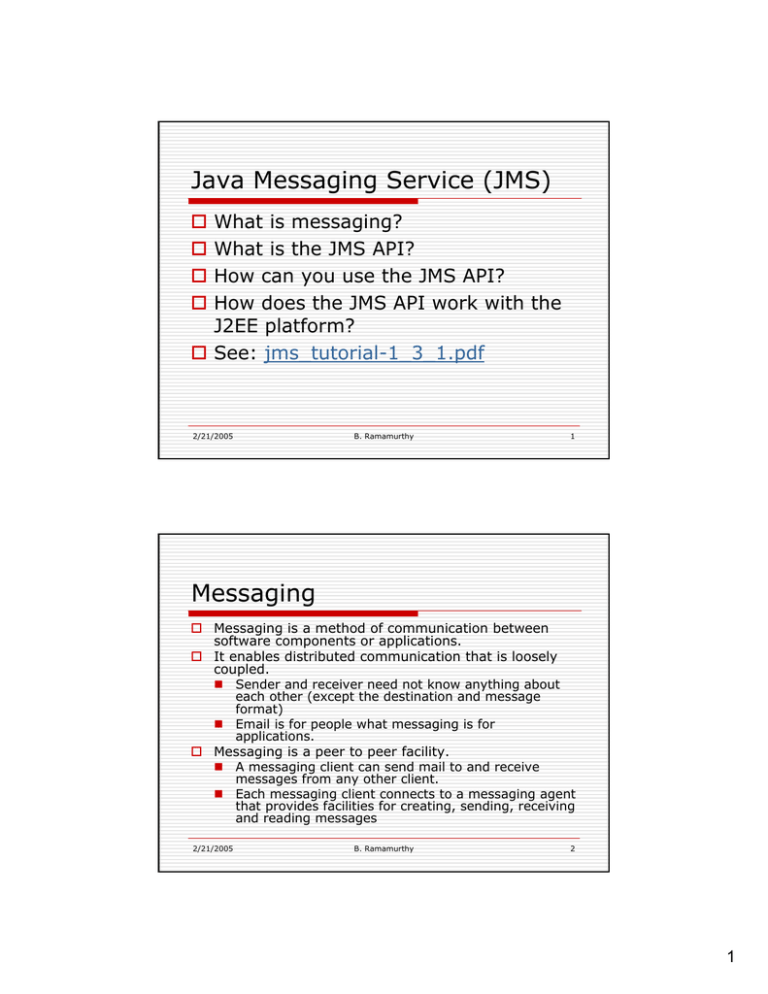Java Messaging Service (JMS)
advertisement

Java Messaging Service (JMS) What is messaging? What is the JMS API? How can you use the JMS API? How does the JMS API work with the J2EE platform? See: jms_tutorial-1_3_1.pdf 2/21/2005 B. Ramamurthy 1 Messaging Messaging is a method of communication between software components or applications. It enables distributed communication that is loosely coupled. Sender and receiver need not know anything about each other (except the destination and message format) Email is for people what messaging is for applications. Messaging is a peer to peer facility. A messaging client can send mail to and receive messages from any other client. Each messaging client connects to a messaging agent that provides facilities for creating, sending, receiving and reading messages 2/21/2005 B. Ramamurthy 2 1 JMS API Allows applications to create, send, receive, and read messages. Messages are Asynchronous: a client does not have to request them in order to receive them. Reliable: can ensure message is delivered safely once and only once. 2/21/2005 B. Ramamurthy 3 Using JMS API A provider wants the components not to depend on other components’ interfaces, so that components can be easily replaced. The provider wants the application to run whether or not all components are up and running simultaneously. The application business model allows a component to send information to another and to continue to operate without receiving immediate response. 2/21/2005 B. Ramamurthy 4 2 Examples using JMS Inventory component that can send message to factory component when inventory level for a product goes below a certain level, so that they can make more cars. The parts components in turn can messages to update inventories and order new parts. Both factory and parts components can send messages to the accounting component to update their budget numbers. Business application can publish updated catalog to its sales force. 2/21/2005 B. Ramamurthy 5 Messaging in an Enterprise Application Parts Inventory Parts needed Number low Inventory New items Sales 2/21/2005 Parts Factory Get from inventory Order From outside bill Purchase order Parts Order Accounting B. Ramamurthy 6 3 JMS and J2EE Messaging is an integral part of J2EE 1.3. Application clients, EJB components, and web components can send or synchronously receive a JMS message. Application clients can receive JMS messages asynchronously. Message driven bean enables the asynchronous consumption of messages. Can be used in the place of connector architecture when interacting with existing Enterprise Information Systems (EIS). 2/21/2005 B. Ramamurthy 7 JMS Architecture JMS provider: is a messaging system that implements JMS interfaces and provides administrative and control features. JMS clients: are programs or components written in Java that produce or consume messages. Messages: are objects that communicate information between the JMS clients. Administered objects are preconfigured JMS objects created by an administration for the use of clients. Two kinds of administered objects are destinations and connection factories. 2/21/2005 B. Ramamurthy 8 4 JMS API Architecture Administrative Tool 1: bind JNDI Namespace 2: lookup JMS client JMS Provider 3: Logical connection 1: Bind destinations and connection factories objects 2. Client looks up for administered objects in the namespace 3. Establish a logical connection to the looked up object thru’ a JMS provider. 2/21/2005 B. Ramamurthy 9 Messaging Domains Point-to-Point (PTP) application is built around the concept of message queues, sender and receivers. Each message is addressed to a specific queue and the receiving clients extract messages from the queues established to hold their messages. Each message has only one consumer. A sender and receiver have no time dependencies. The receiver acknowledges the successful processing of a message. Use PTP when every message you send must be processed successfully by one consumer. 2/21/2005 B. Ramamurthy 10 5 Publish/Subscribe domain Clients address messages to a topic. Each message may multiple consumers. Publishers and subscribers have timing dependencies. Publishers and subscribers are generally anonymous and the system takes care of distributing the messages. 2/21/2005 B. Ramamurthy 11 Message Consumption Synchronously: A subscriber or receiver explicitly fetches the message from the destination by calling the receive method. Asynchronous: A client can register a message listener with a consumer. A message listener is similar to an event listener. Whenever a message arrives at the destination, the JMS provider delivers the message by calling the listener’s onMessage method, which acts on the content. 2/21/2005 B. Ramamurthy 12 6


